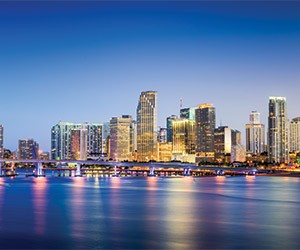Given how social media and mobile technology are playing an ever-increasing role in site selection and the way visitors are accessing destination information, it’s little wonder that CVBs/DMOs are stepping up their approach to digital marketing. Mobile apps, Twitter command centers, meetings microsites and partnerships with local bloggers are all important tools that destination marketers are using to boost a city’s appeal and improve visitor engagement.
Taking this approach is absolutely necessary in today’s environment, according to Katie Cook, director of digital marketing for Visit Austin.
“CVBs should continue to watch trends on how people are communicating and looking for information so that they enhance the overall destination experience,” she said. “As visitors and meeting attendees get more and more social media savvy, they are expecting CVBs to be present and responsive on these networks.”
Christine Shimasaki, managing director of the empowerMINT.com & Event Calculator Tool division of DMAI, the leading association for destination marketing organizations, noted that many DMAI members are using their already extensive content databases in new ways to help meeting planners market their events and improve the meeting experience.
“For instance, DMOs are empowering association planners to promote their meetings by giving them landing pages, microsites and digitalized content they can use,” she said. “Pinterest and Instagram are being used for this as well—and the majority of DMOs are building Pinterest and Instagram sites for their destinations. Destinations and planners alike are concerned with attracting younger people, so they need to be in those channels.”
Mobile apps are also gaining ground among destination marketers, some containing general tourist information such as Tourism Vancouver’s “CitySmart,” while others such as the Louisville CVB’s “Urban Bourbon Trail” and the Nashville CVB’s “Live Music Guide” focus on a specific aspect the destination is known for.
“Mobile apps are the way many attendees are really digging into a destination,” said meetings technology consultant Corbin Ball, adding that CVBs are wise to develop apps of their own despite the fact that a plethora of travel apps are also available from other sources.
“Apps are an important way that CVBs can remain relevant in a world where so many people are getting their information from places like Google and TripAdvisor,” he said. “This is a way of branding your destination and staying at the center of it.”
Here’s a sampling of creative ways some CVBs are using digital tools to enhance their meetings and tourism appeal.
PageBreak
Annapolis, Md.
At Visit Annapolis, the Annapolis Now app, a comprehensive guide to attractions, hotels, restaurants and special events, is proving to be a useful tool for planners and attendees alike, according to spokeperson Susan Steckman. The app is updated frequently and promoted everywhere from hotel front desks to drink coasters at local pubs and restaurants, she said.
Austin, Texas
At the Austin CVB, a multi-pronged social media program includes meetings-specific accounts on Facebook and Twitter as well as a blog and a presence on Instagram, Flickr, YouTube, Vimeo and Pinterest.
“We also started a program called True Austin that allows some of our local bloggers and influencers to answer visitor questions on social media and email,” Cook said. “Visitors and meeting planners want to know what the locals recommend and love the personalized service.”
Baltimore
Visit Baltimore has developed an app specifically for meeting planners to use when researching event spaces. Called “Baltimore InSite,” the app includes a three-dimensional mapping tool of local attractions and meeting venues, including the Baltimore Convention Center.
Birmingham, Ala.
Birmingham recently launched “IN Guide,” a mobile app that includes extensive lists of restaurants, coffee shops, boutiques, attractions, hotels and events, with directions and contact information. Users can post comments and create a customized day trip with the Invent A Day feature.
Chicago
For large meetings and shows, Choose Chicago will set up a command center on Twitter where attendees can get answers to questions and assistance with problems.
“For instance, anyone having an issue at the airport can get help immediately from someone who’s monitoring the tweets coming in,” said Rose Horcher, vice president of client services. “At a recent meeting, we used it to retrieve a laptop left at the hotel.”
Indianapolis
Visit Indy is using Twitter to build excitement and answer questions from attendees before they arrive in Indianapolis. About two weeks prior to a meeting, Visit Indy starts communicating with attendees via the organization’s event hashtag, said spokesperson Lisa Wallace.
“We can discuss anything from transportation options to where to get a cup of the best local coffee,” she said.
Louisville, Ky.
The Louisville CVB enables planners to tap into prepared content on restaurants and attractions that they can post on Facebook, Twitter and other platforms, said Gathan Borden, director of brand marketing.
“All the planner has to do is insert their meeting hashtag, plug in their group name and they have a full-on social media plan,” he said. “They can pick up whatever they want, including Tweets and Facebook posts we’ve created, and share it with their attendees.
Napa, Calif.
At Visit Napa Valley, one objective of the Visit Napa Valley App is to encourage meeting attendees to extend their stay in the region before or after the meeting, said President and CEO Clay Gregory. Along with comprehensive visitor information, the app enables users to book hotels and wine tasting experiences, and find out about special offerings and discounts at specific wineries.
Nashville
The Nashville CVB’s “Live Music Guide” enables visitors to access information about where and when artists are appearing at various spots around the city.
“Music is our brand and our product—it was important for us to have an app that really addresses this,” said Deana Ivey, chief marketing officer for the CVB. “Meeting planners ask about it and we promote it at the registration desk. It’s very handy for people to use when they want to go out after functions. It has augmented reality, so when you step outside the hotel or convention center, you’ll see what’s happening within a few blocks of where you are.”
Valley Forge, Pa.
“The old adage that a picture is worth a thousand words no longer applies to modern digital marketing,” said Edward Harris, vice president of marketing and communications for Valley Forge Tourism and Convention Board (VFTCB).
To that end, the VFTCB launched the cutting-edge Montco360.net, offering more than 30 interactive virtual tours of the most popular attractions and event venues in Montgomery County, all filmed with drones.
Vancouver, B.C.
Tourism Vancouver encourages local bloggers to post content on the bureau’s Inside Vancouver website.
“It’s very personalized information that gives the viewpoint of those who live here, whether it’s about where to take a bike ride or where to get a great glass of wine,” said Dave Gazley, vice president of meeting and convention sales. “People are looking for authentic experiences.”







